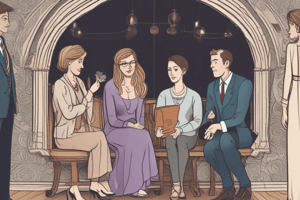Podcast
Questions and Answers
According to Green, what are the three distinct positions concerning same-sex marriage?
According to Green, what are the three distinct positions concerning same-sex marriage?
- Social Conservatives, Critical Feminist/Queer, Liberal Feminists
- Social Conservatives, Critical Feminist/Queer, Liberal Assimilationists
- Social Conservatives, Critical Feminist/Queer, Lesbian and Gay Assimilationists (correct)
- Social Conservatives, Progressive Feminists, Lesbian and Gay Assimilationists
What is the primary argument of Social Conservatives regarding same-sex marriage?
What is the primary argument of Social Conservatives regarding same-sex marriage?
- They support same-sex marriage as a way to create greater equality.
- They advocate for the deconstruction of traditional gender roles within marriage.
- They question the legitimacy of marriage as a social institution for both same-sex and heterosexual couples.
- They believe in the importance of heteronormative marriage as the foundation of society. (correct)
How do Critical Feminist/Queer theorists view same-sex marriage?
How do Critical Feminist/Queer theorists view same-sex marriage?
- They believe marriage is outdated and should be abolished entirely.
- They believe that all genders are equal and should have the right to legal marriage.
- They believe that same-sex marriage reinforces patriarchal structures and societal expectations surrounding marriage. (correct)
- They support same-sex marriage as a way to achieve greater social equality for LGBTQ individuals.
What is the motivation behind the Lesbian and Gay Assimilationist position on same-sex marriage?
What is the motivation behind the Lesbian and Gay Assimilationist position on same-sex marriage?
Which of the following is NOT a key argument of Social Conservatives regarding same-sex marriage?
Which of the following is NOT a key argument of Social Conservatives regarding same-sex marriage?
What is the key impact the feminist movement had on the institution of marriage in Canada, as described in the text?
What is the key impact the feminist movement had on the institution of marriage in Canada, as described in the text?
How do same-sex couples in Canada navigate the balance between tradition and innovation in marriage?
How do same-sex couples in Canada navigate the balance between tradition and innovation in marriage?
What concept is introduced to explain the tension between traditional marriage and same-sex marriage?
What concept is introduced to explain the tension between traditional marriage and same-sex marriage?
What is a significant barrier for gay men adopting children in Ontario, as mentioned in the text?
What is a significant barrier for gay men adopting children in Ontario, as mentioned in the text?
How do gay men in Ontario approach the concept of 'difference' when adopting, according to the text?
How do gay men in Ontario approach the concept of 'difference' when adopting, according to the text?
What is the central argument regarding same-sex marriage as presented by Adam Isaiah Green in the text?
What is the central argument regarding same-sex marriage as presented by Adam Isaiah Green in the text?
What significant barrier do gay men face when adopting children in Ontario, according to the provided text?
What significant barrier do gay men face when adopting children in Ontario, according to the provided text?
What does "adopting difference" refer to in the context of the text?
What does "adopting difference" refer to in the context of the text?
Which statement accurately describes the traditional view of marriage?
Which statement accurately describes the traditional view of marriage?
What factor significantly influences how families are imagined and experienced?
What factor significantly influences how families are imagined and experienced?
What was the societal perception of having children outside of marriage prior to 1969?
What was the societal perception of having children outside of marriage prior to 1969?
What is the definition of a nonbinary couple?
What is the definition of a nonbinary couple?
What characterized indigenous families according to the content?
What characterized indigenous families according to the content?
Which gender roles were typically attributed to men and women in the traditional family structure?
Which gender roles were typically attributed to men and women in the traditional family structure?
What was the societal stance on birth control and abortion until 1969?
What was the societal stance on birth control and abortion until 1969?
What foundational view of families is suggested in the content?
What foundational view of families is suggested in the content?
What is meant by "couple culture" according to Shelley Budgeon?
What is meant by "couple culture" according to Shelley Budgeon?
How does "couple culture" impact perceptions of single individuals?
How does "couple culture" impact perceptions of single individuals?
What is a social implication of the cultural ideal of coupledom?
What is a social implication of the cultural ideal of coupledom?
What do Evans et al. argue about co-residence?
What do Evans et al. argue about co-residence?
How is the stereotype of "boomerang children" addressed by the authors?
How is the stereotype of "boomerang children" addressed by the authors?
What is a significant societal pressure discussed regarding young adults leaving their parental home?
What is a significant societal pressure discussed regarding young adults leaving their parental home?
How is divorce often constructed, according to Coltrane and Adams?
How is divorce often constructed, according to Coltrane and Adams?
In discussions about divorce, how are children typically portrayed?
In discussions about divorce, how are children typically portrayed?
Why do Coltrane and Adams consider the portrayal of children as 'victims' in divorce discourse problematic?
Why do Coltrane and Adams consider the portrayal of children as 'victims' in divorce discourse problematic?
What alternative understanding of divorce do Coltrane and Adams propose?
What alternative understanding of divorce do Coltrane and Adams propose?
How does Carole Smart view the moral implications of divorce in modern society?
How does Carole Smart view the moral implications of divorce in modern society?
What does Carole Smart argue regarding the concept of 'moral decline' in relation to divorce?
What does Carole Smart argue regarding the concept of 'moral decline' in relation to divorce?
What does the narrative approach assume about language in relation to singlehood?
What does the narrative approach assume about language in relation to singlehood?
What stigma is associated with being single, as mentioned in the content?
What stigma is associated with being single, as mentioned in the content?
How is singlehood today viewed in contrast to the past?
How is singlehood today viewed in contrast to the past?
What do participant narratives about singlehood primarily suggest?
What do participant narratives about singlehood primarily suggest?
What significant change in family definitions has occurred over the last 100 years?
What significant change in family definitions has occurred over the last 100 years?
According to Anne Mila, what societal change has had a significant impact on family dynamics?
According to Anne Mila, what societal change has had a significant impact on family dynamics?
What effect did the Great Depression have on family structures?
What effect did the Great Depression have on family structures?
What role has technology played in shaping family life in the 20th century?
What role has technology played in shaping family life in the 20th century?
What challenge do families face today compared to those a century ago?
What challenge do families face today compared to those a century ago?
How has gender roles within families evolved over the past century?
How has gender roles within families evolved over the past century?
What has contributed to the rise of single-parent families?
What has contributed to the rise of single-parent families?
What prediction does Mila make about the future of families in the next 100 years?
What prediction does Mila make about the future of families in the next 100 years?
Flashcards
T-discourses
T-discourses
Sociological claims linked to professional, policy, and political discussions.
Social conservatives
Social conservatives
Group emphasizing traditional family values, one man and one woman.
Critical feminist and queer theorists
Critical feminist and queer theorists
They question marriage as a meaningful social institution.
Lesbian and gay assimilationists
Lesbian and gay assimilationists
Signup and view all the flashcards
Three positions on same-sex marriage
Three positions on same-sex marriage
Signup and view all the flashcards
Couple Culture
Couple Culture
Signup and view all the flashcards
Perception of Singles
Perception of Singles
Signup and view all the flashcards
Marginalization of Singles
Marginalization of Singles
Signup and view all the flashcards
Singleness Perspective
Singleness Perspective
Signup and view all the flashcards
Coresidence
Coresidence
Signup and view all the flashcards
Boomerang Children
Boomerang Children
Signup and view all the flashcards
Divorce as Moral Problem
Divorce as Moral Problem
Signup and view all the flashcards
Children in Divorce
Children in Divorce
Signup and view all the flashcards
Divorce Act of 1968
Divorce Act of 1968
Signup and view all the flashcards
Cohabitation Laws
Cohabitation Laws
Signup and view all the flashcards
Monogamy
Monogamy
Signup and view all the flashcards
Process-based definitions of families
Process-based definitions of families
Signup and view all the flashcards
Evolution of Family Definition
Evolution of Family Definition
Signup and view all the flashcards
Impact of the Great Depression
Impact of the Great Depression
Signup and view all the flashcards
Technological Advancements
Technological Advancements
Signup and view all the flashcards
Rise of Single-Parent Families
Rise of Single-Parent Families
Signup and view all the flashcards
Traditional Family
Traditional Family
Signup and view all the flashcards
Indigenous Families
Indigenous Families
Signup and view all the flashcards
Census
Census
Signup and view all the flashcards
Stigma
Stigma
Signup and view all the flashcards
Gender Constructs
Gender Constructs
Signup and view all the flashcards
Single Motherhood Causes
Single Motherhood Causes
Signup and view all the flashcards
Family as Units of Consumption
Family as Units of Consumption
Signup and view all the flashcards
Gender Diversity Status
Gender Diversity Status
Signup and view all the flashcards
Child Victims in Divorce
Child Victims in Divorce
Signup and view all the flashcards
Nuanced Understanding of Divorce
Nuanced Understanding of Divorce
Signup and view all the flashcards
Divorce and Moral Norms
Divorce and Moral Norms
Signup and view all the flashcards
Moral Decline and Divorce
Moral Decline and Divorce
Signup and view all the flashcards
Normalizing Divorce
Normalizing Divorce
Signup and view all the flashcards
Singlehood Definition
Singlehood Definition
Signup and view all the flashcards
Stigma of Singlehood
Stigma of Singlehood
Signup and view all the flashcards
Narrative Approach to Singlehood
Narrative Approach to Singlehood
Signup and view all the flashcards
Feminist movement impact
Feminist movement impact
Signup and view all the flashcards
Modern view of love in marriage
Modern view of love in marriage
Signup and view all the flashcards
Same-sex marriage argument
Same-sex marriage argument
Signup and view all the flashcards
Marriage innovation
Marriage innovation
Signup and view all the flashcards
Legal recognition for same-sex couples
Legal recognition for same-sex couples
Signup and view all the flashcards
Barriers for gay men adopting
Barriers for gay men adopting
Signup and view all the flashcards
Negotiating difference
Negotiating difference
Signup and view all the flashcards
Adopting difference
Adopting difference
Signup and view all the flashcards
Study Notes
Social Construction of Divorce
- Divorce is viewed as a social problem, a moral failing and linked to changing family practices.
- Early American marriage was seen as a social order, harmony and patriotic duty.
- Labour-based societal thought separates roles, with women in the home and men in public life.
Multiple Choice Questions
- Three distinct positions regarding same-sex marriage:
- Social conservatives
- Critical feminist/queer theorists
- Lesbian and gay assimilationists
Indigenous Family Structures
- Indigenous families often involve complex households with multiple caregivers and diverse kinship systems.
- Indigenous family structures are understood as an open system, encompassing extended family and community members.
- Kinship care is a frequently observed practice.
Family Dynamics
- Technology significantly impacted family life in the 20th century.
- Technological advancement facilitated greater togetherness amongst families.
- Women's growing participation in the workforce has significantly altered family structures and roles.
Same-Sex Marriage
- Same-sex couples often seek legal recognition and societal acceptance.
- Same-sex couples navigate the balance between traditional and contemporary marriage practices.
- Same-sex couples often bring new understandings to the institution of marriage.
Divorce
- Divorce in early Canada was viewed as a moral failure.
- Divorce was also considered a complex legal process.
- Modern views of divorce are often understood as normal.
- Divorce is increasingly viewed as a part of evolving family practices and not a moral failure.
Studying That Suits You
Use AI to generate personalized quizzes and flashcards to suit your learning preferences.




